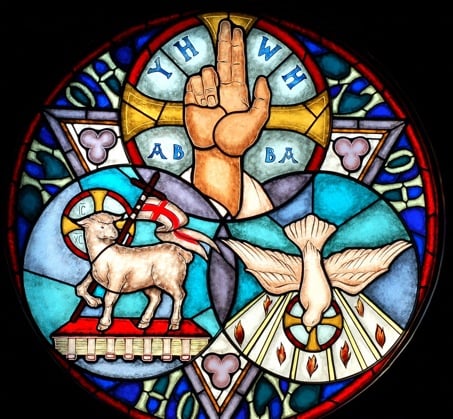The Day of Atonement
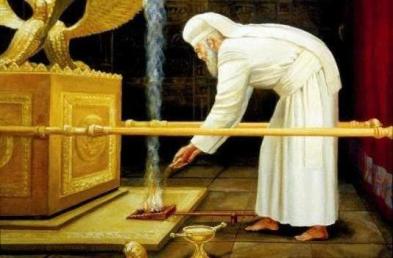
“This is to be a lasting ordinance for you: On the tenth day of the seventh month you must deny yourselves and not do any work—whether native-born or a foreigner residing among you—because on this day atonement will be made for you, to cleanse you. Then, before the Lord, you will be clean from all your sins.
Leviticus 16.29-30 (NIV)
The Day of Atonement, or Yom Kippur, is the holiest day in the Jewish calander. It is the day when observant Jews ask for God’s forgiveness for their sins over the past year and is marked by fasting, abstinence, prayer and ritual. According to Scripture this day was instituted by the Lord through His servant Moses and in biblical times it was the date of a solemn ritual of atonement, performed by the High Priest within the tabernacle and later the temple. For Christians, the Day of Atonement was replaced by the once-and-for-all sacrifice on the cross, where Jesus Christ, our High Priest, atoned for our sins.
The Day of Atonement falls on the 10th day of the seventh month of the Jewish calender, which is late September or early October, calendrically close to 9/11 (as an aside, the 10th day of the seventh month in our Gregorian calender is usually the 191st day of the year). In previous pages I have shown how the terrorist attacks of 9/11 symbolised the crucifixion and resurrection of Jesus Christ. In this page I will show that 9/11 also represented the Day of Atonement.
The Tabernacle
The Tabernacle, which was the basis for the Jerusalem Temple, was a portable temple and the centre of the Israelites’ religious life. It was built to precise instructions, given in the Book of Exodus. The structure revealed by these instructions is shown in schematic form below.
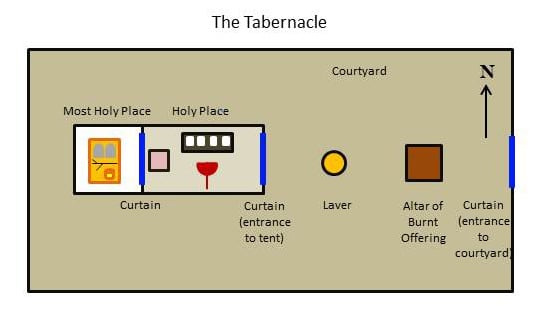
The Tabernacle consisted of a courtyard and two sanctuaries. The outer sanctuary, or Holy Place, contained a lampstand, showbread table and the Altar of Incense [1] The inner sanctuary, or Most Holy Place, contained the Ark of the Testimony. The Ark had a lid, the atonement cover, on which were two cherubim, between which the Glory of the Lord would appear, and where the High Priest would present himself on the Day of Atonement to make the necesary sacrifices.
The Ark itself contained the two tablets inscribed with the Ten Commandments and was also associated with Aaron’s staff that budded, the pot of manna and the Book of the Law. The other major structure was the Altar of Burnt Offering, used for burning offerings to the Lord. These offerings were made daily and on special holy days, the Day of Atonement of course being the most holy day of all.
Entrance to the Holy Place was reserved for the priesthood and entrance to the Most Holy Place was the exclusive right of the High Priest. Even he could enter only on the Day of Atonement, only after washing and purification and then only to perform his duties in the Rite of Atonement. Entry into this room was strictly forbidden at all other times. The reason for these extreme restrictions on entrance was that the Most Holy Place was the physical location where YHVH was present among his people and therefore too holy to be profaned by the presence of sinful man. The almost total exclusion of the Israelites from the Most Holy Place helped to maintain its sanctity and symbolised their exiled status.
For the High Priest to enter the Most Holy Place he had to cross three thresholds:
1. the door to the outer court, separating the Tabernacle from the outside world;
2. the entrance to the tent, separating the Holy Place from the outer court;
3. the curtain, separating the Most Holy Place from the Holy Place.
Although only the curtain was named as such, all three barriers were curtains.
The Rite Of Atonement
The high priest purified God's sanctuary and made reparation for his own sins and the sins of his people through the performance of a rite of atonement. The entire ritual was performed according to the instructions found in Leviticus 16. These required five animals, which would be sacrificed in the following order:
1. A bullock was sacrificed as a sin offering for the High Priest.
2. A young goat was sacrificed as a sin offering for the people.
3. Another young goat, the scapegoat, had the sins of the peopel laid upon it, then was led into the wilderness (this was also considered to be a sacrifice).
4. A ram was sacrificed as a burnt offering for the High Priest.
5. Another ram was sacrificed as a burnt offering for the people.
After securing the animals and dressing in special garments prescribed for the ceremony, the High Priest proceeded as follows:
1. A prayer of confession was made, the bullock was slaughtered and its blood was collected.
2. The Most Holy Place was entered for the first time, and a cloud of incense created inside, to protect the priest from the splendour of the Lord.
3. The Most Holy Place was entered for a second time and the bull's blood sprinkled on the Atonement Cover of the Ark of the Testimony and into the room, to make atonement for his sins and the sins of his household.
4. The goat was sacrificed and the blood collected.
5. The Most Holy Place was entered for the third time and the goat's blood sprinked on the Atonement Cover and into the room, this time to make atonement for the sins of the people.
6. In the Holy Place, both the bull’s blood and goat’s blood were sprinkled onto the curtain separating inner and outer sanctuary.
7. The bloods were mixed and sprinkled onto the altar of incense to cleanse it. Finally, the blood was poured out at the base of the altar of burnt offering. In this way, the entire sanctuary was ritually cleansed.
8. The sins of the people were confessed over the scapegoat, which was then led into the desert, taking away the sins of the people for another year. The carcasses of the sacrificed animals were burnt outside the city.
9. One ram was sacrificed as a burnt offering to make atonement for the High Priest.
10. The other ram was sacrificed as a burnt offering to make atonement for the people.
The ceremony ended with the High Priest reciting further prayers and bible readings, burning the remains of the sin offerings and washing himself and his garments. So by the sacrifice of valuable livestock, in the manner prescribed by the Hebrew Bible, the High Priest ritually purified the Tabernacle and made atonement for the sins of the Israelites over the previous twelve months.
There is much of interest here, but I would initially like to point out that not only does the High Priest cross three thresholds to reach the Most Holy Place, he also enters the Most Holy Place three times in the performance of his duties. Note that on 9/11 there were three successful air attacks.
The Atonement Sacrifices
Now to the atonement sacrifices themselves. Here they are again, in the order in which they were performed:
1. A bullock was sacrificed as a sin offering for the High Priest.
2. A young goat was sacrificed as a sin offering for the people.
3. Another young goat, the scapegoat, had the sins of the people laid upon it, then was led into the wilderness.
4. A ram was sacrificed as a burnt offering for the High Priest.
5. Another ram was sacrificed as a burnt offering for the people.
There were five separate events on 9/11: the air attacks on towers 1 and 2, the air attack on the Pentagon, the hijacked airplane that crashed near Shanksville and the fall of tower 7. Each of the atonement sacrifices was represented by one of these events, as I show below.
1 and 2: The Bullock and the Goat
The attacks by Flights 11 and 175 were the first two events to occur on 9/11. Flight 11 struck at 8.46AM and Flight 175 struck at 9.03AM. These would symbolise the first two sacrifices by the High Priest, those of the bullock and the goat.
The sacrifice of the bullock was for sins of the High Priest and his household, which fits perfectly with the flight number of the equivalent 'sacrifice' on 9/11, because this is 11, the reduced value of 'Jesus', Jesus Christ being our High Priest. The clustering of elevens around 9/11 is well known.
3: The Scapegoat
The next event to take place on 9/11 was the hijacking of Flight 93 at 9.28AM. At 9.35AM the flight veered off course towards Pennsylvania and, after the heroic actions by pasengers in overcoming the hijackers, crashed in Somerset County at 10.03AM. This was equivalent to the release of the scapegoat into the wilderness, which was the next sacrifice to take place on the Day of Atonement. The 'wilderness' in this case was the countryside in Somerset County, Pennsylvania.
4: The First Ram
The next attack was on the Pentagon, by Flight 77, which hit the building at 9.37AM. This was equivalent to the sacrifice of the first ram, for the High Priest.
The flight number again suggests our High Priest Jesus Christ, because 77, in addition to being a multiple of 11, is the ordinal value of 'Christ.' The Pentagon itself, through it's encoding of the number five, represents the five wounds Christ suffered during his crucifixion and the five petalled rose, also a symbol of our Lord. This is related in more detail in The September-11 Crucifix.
5: The Second Ram
The collapse (or demolition) of WTC7, at 5.00PM, represented the final sacrifice, that of the ram for the sins of the people. The previously inexplicable fall of this tower can now be seen as an essential part of the day's events, completing the Day of Atonement Sacrifices.
The Five 'Sacrifices' on 9/11
I have tabulated the above information for easy reference, so you can see how each of the Day of Atonement sacrifices was matched by a corresponding 'sacrifice' on 9/11, taking place in the same order.
| Day of Atonement Sacrifices (in order) | Equivalent Sacrifice on 9/11 | Time |
| Sacrifice of a bullock for the High Priest | Attack on WTC1 by Flight 11 | 8.46AM |
| Sacrifice of a goat for the people | Attack on WTC2 by Flight 175 | 9.03AM |
| Release of the scapegoat into the wilderness | Veering off course of Flight 93. | 9.28AM |
| Sacrifice of a ram for the High Priest | Attack on Pentagon by Flight 77 | 9.37AM |
| Sacrifice of a ram for the people | Collapse of WTC7 | 5.20PM |
Further parallels can be drawn between 9/11 and the Day. These are summarised below.
The Most Holy Place and the 9/11 Cubes
According to the Bible the Most Holy Place had the dimensions of a cube, a symbol of perfection. The Most Holy Place within the tabernacle was thought to have an external length, breadth and height of 10 cubits. The Most Holy Place within the Jerusalem temple was 20 cubits on a side - notice how the inner sanctuary has increased in size. In Revelation we are told that the New Jerusalem, God’s final sanctuary on earth, will be a cube 12000 stadia on a side. So we see the Most Holy Place, whilst always remaining a cube, increases in size from the tabernacle of the children of Israel to the Jerusalem Temple and again to the New Jerusalem, this progression suggesting three cubes of increasing size.
In The September-11 Crucifix I show how the 9/11 targets encode the numbers describing a series of three nested cubes, those of 5, 7 and 9. Here is a short summary of the relevant information.
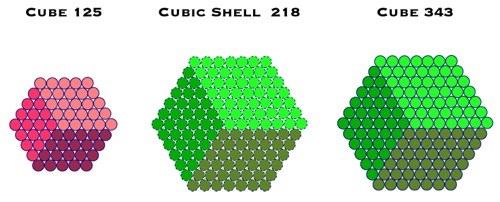
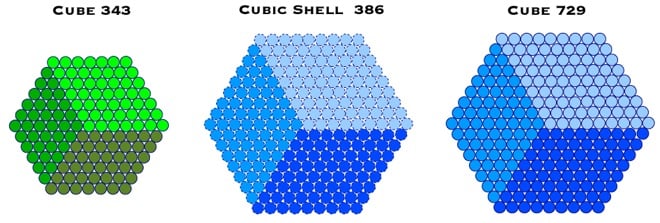
| The Pentagon (o)............................................ | = 125 = 5 x 5 x 5 |
| The World Trade Centre (o) + 125.................... | = 343 = 7 x 7 x 7 |
| The North Tower + the South Tower (o) + 343... | = 729 = 9 x 9 x 9 |
So within the Bible and encoded into the 9/11 targets are three cubes of increasing dimensions.
The connection between these three cubes of increasing size and the three ever larger versions of the Most Holy Place described in Scripture is fixed when we consider the significance of the Crucifixion, which 9/11 also represented. In Hebrew, one of the names for the Ark, used in 1 Sam. 3:3, is Arun Elohim, the Ark of God. This has a numerical value of 343, the same as the second of the three cubes. As shown in The September-11 Crucifix, this is the cube that opens out to form a cross, representing the Cross on which Jesus was crucified, and 343 is the ordinal value of Matthew's version of the Superscription above the Cross: THIS IS JESUS, THE KING OF THE JEWS. Thus, Jesus is our Ark, and of course, our Atonement Cover, his shed blood atoning for our sins, once and for all. Interestingly, the standard value of the Hebrew for 'The Ark of the Testimony' is 778, which is the same as that of the English name and title 'Jesus Messiah'.
The identification of the Pentagon with the Most Holy Place is strengthened by the encoding of further cubes into the Pentagon attack:
1. 125 (5 cubed) Pentagon employees were killed
2. 64 (4 cubed) passengers were on the attacking plane
3. The name 'the Pentagon' has an ordinal value of 125
4. The Pentagon represented the crucified Lord on 9/11 and for Christians Jesus Christ is our Most Holy Place.
The number 5, representing Christ's wounds, God's grace and the rose (with five petals) adds further meaning to the message being delivered here.
The Clouds of Incense and the Sprinkling of Blood
As I showed earlier, the High Priest had various duties to perform inside the Tabernacle. Steps 1 to 7 of these are given again.
1. A prayer of confession was made, the bullock was slaughtered and its blood was collected.
2. The Most Holy Place was entered for the first time, and a cloud of incense created inside, to protect the priest from the splendour of the Lord.
3. The Most Holy Place was entered for a second time and the bull's blood sprinkled on the Atonement Cover of the Ark of the Testimony and into the room, to make atonement for his sins and the sins of his household.
4. The goat was sacrificed and the blood collected.
5. The Most Holy Place was entered for the third time and the goat's blood sprinked on the Atonement Cover and into the room, this time to make atonement for the sins of the people.
6. In the Holy Place, both the bull’s blood and goat’s blood were sprinkled onto the curtain separating inner and outer sanctuary.
7. The bloods were mixed and sprinkled onto the altar of incense to cleanse it. Finally, the blood was poured out at the base of the altar of burnt offering. In this way, the entire sanctuary was ritually cleansed.
An important part of the ceremony was performed in step 2, when the High Priest released clouds of incense into the Most Holy Place to protect himself from the 'Glory of the Lord'. This was reenacted on 9/11 by the billowing clouds of smoke issuing from the two towers.
The sacrifice of the two animals in steps 1 and 4 were reenacted in the attacks on the towers. However, their blood was then sprinkled on the Most Holy Place, the Holy Place and poured at the base of the Altar of Burnt Offering (steps 3, 5, 6 and 7). This was reenacted on 9/11 by the burning and the collapse of the twin towers, during which many people were killed. [2] Their blood was shed for our sins.
The Five 'Sacrifices' on 9/11 in More Detail
Let's now redo the table above, this time incorporating some of the new information.
| Day of Atonement Sacrifices (in order) | Equivalent Sacrifice on 9/11 | Time |
| Sacrifice of a bullock for the High Priest | Attack on WTC1 by Flight 11 | 8.46AM |
| Release of clouds of incense | Smoke billowing from WTC1/2 | 8.46AM onwards |
| Sprinkling/pouring of blood at various locations | Deaths of 9/11 victims during burning and collapse of WTC1/2 | 8.46AM onwards |
| Sacrifice of a goat for the people | Attack on WTC2 by Flight 175 | 9.03AM |
| Release of the scapegoat into the wilderness | Veering off course of Flight 93. | 9.28AM |
| Sacrifice of a ram for the High Priest | Attack on Pentagon by Flight 77 | 9.37AM |
| Sacrifice of a ram for the people | Collapse of WTC7 | 5.20PM |
Encodings within the NIV Bible reafirm these correspondences between 9/11 and the Day. For instance, Exodus 27 and 38 detail the Lord's instructions for the construction of, and the actual construction of, the Altar of Burnt Offering. These are the Bible's 77th and 88th chapters, both numbers being multiples of 11, the primary number encoded into 9/11. The number 11 is also the reduced value of 'Jesus' and 77 and 88 the ordinal values of 'Christ' and 'Immanuel', again linking 9/11 and the Day of Atonement to his Crucifixion.
The Temple
In the time of Jesus the Day of Atonement sacrifices took place in the Jerusalem Temple. Let's look at a diagram of the temple to see if my hypothesis works in this setting. There were two versions of the temple, both with the same essential structure as the earlier Tabernacle, although differing in many details. The first, Soloman's Temple, was destroyed. A second was built in the time of Ezra and Nehemiah and later extended by Herod. The Second Temple is shown below.
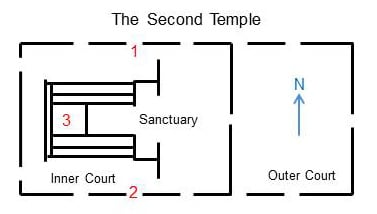
The layout was more complex than the Tabernacle. Instead of one entrance to the outer court there were now a large number of gates, possibly thirteen (the exact number is not known). Only two are identified here, the two gates used for offerings. The Sacrifice Gate (1) was situated on the north side of the of the temple precinct and was the only gate used for Day of Atonement offerings. The Firstborn Gate (2) on the south side was used for entering with offerings of firstborn animals. The only other feature I have marked is the Most Holy Place (3), which was protected by a double curtain, the curtain that was torn at the moment Jesus died.
The relative locations of the two gates meant that people entering by them would come down from the north or up from the south. This is the direction that the two airplanes attacking the twin towers took on 9/11.
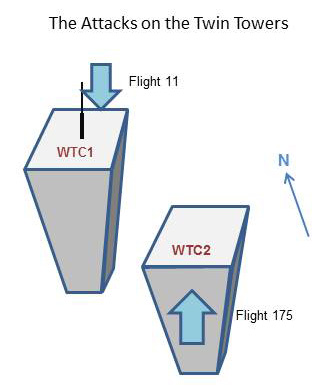
There is a clear parallel here between 9/11 and temple sacrifices. The attack on the north tower (WTC1) by Flight 11 symbolised entrance to the temple via the sacrifice gate (1). the attack on the south tower (WTC2) by Flight 175 represented entrance to the temple via the firstborn gate (2). This also points to the sacrifice of Jesus Christ, the 'firstborn son'. The attack on the Pentagon by Flight 77 would then represent the entrance by the High Priest into the Most Holy Place (3).
So whether it is viewed in terms of the Tabernacle or the Temple, 9/11 appears to have symbolised the Day of Atonement sacrifices.
9/11 and the Day of Atonement
The association of 9/11 with the Day of Atonement is illustrated in the Garden, a holographic matrix of encodings summarising the New Bible Code, found within the first five verses of Genesis.

Each of the three numbers end at the same point and are found only once in the Garden.
The Day of Atonement and Gematria
The phrase 'the Day of Atonement' itself has some interesting gematria associated with it. First, the ordinal value, which again suggests 9/11
The Day of Atonement (o) = 191
The standard value is of even more interest, because of its factors and because of another phrase which is numerically equal to it.
| The Day of Atonement (s) | = 1595 |
| The Second Coming of Jesus Christ (s) | = 1595 |
1595 factorises into 11 x 5 x 29. All three numbers are vitally important to the New Bible Code. 11 and 5 were encoded into 9/11 and the Pentagon. 11 is also the reduced value of 'Jesus' and 29 is the reduced value of 'Messiah'.
Summary
Another facet of 9/11 is revealed: it represented the Day of Atonement, when reparation was made for the sins of the ancient Israelites through animal sacrifices. The essential elements of the ancient ceremony of Yom Kippur were closely followed on 9/11 and the Kohan Gadol (High Priest) on this occasion was Jesus Christ, our High Priest.
I showed in the previous page that 9/11 also represented the Crucifixion, the blood sacrifice made by Jesus Christ on the cross, which, as the final atonement for sins, superceded the Day of Atonement. In that respect, 9/11 also represented the tearing of the temple curtain (powerfully symbolised by the airplane strikes) at the moment Jesus died on the cross, symbolised the shattering of the barrier between God and His people.
Bill Downie 19/7/09
Latest Update 28/4/17
Notes
1. According to Hebrews 9.4 the Altar of Incense was within the Most Holy Place.
2. Tower 2 fell before tower 1, reversing the order of the 'sprinkling' during the ceremony. However, there is a specific reason for this reversal, dealt with in The September-11 Cube.
